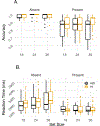A Magnetic Resonance Spectroscopy Study of Superior Visual Search Abilities in Children with Autism Spectrum Disorder
- PMID: 31909886
- PMCID: PMC7688022
- DOI: 10.1002/aur.2258
A Magnetic Resonance Spectroscopy Study of Superior Visual Search Abilities in Children with Autism Spectrum Disorder
Abstract
Although diagnosed on the basis of deficits in social communication and interaction, autism spectrum disorder (ASD) is also characterized by superior performance on a variety of visuospatial tasks, including visual search. In neurotypical individuals, region-specific concentrations of the inhibitory neurotransmitter gamma-aminobutyric acid (GABA) are associated with individual differences in attention and perception. While it has been hypothesized that ASD may be associated with an excitatory-inhibitory imbalance, it remains unclear how this may contribute to accelerated visual search performance in individuals with ASD. To investigate this, 21 children with ASD and 20 typically developing children participated in a visual search task and a magnetic resonance spectroscopy study to detect neurochemical concentrations, including GABA. Region-specific neurochemicals were examined in the right frontal eye fields, right temporal-parietal junction (rTPJ), and bilateral visual cortex (VIS). GABA concentrations did not differ between groups; however, in children with ASD, greater GABA concentration in the VIS was related to more efficient search. Additionally, lower VIS GABA levels were also associated with increased social impairment. Finally, we found reduced N-acetyl aspartate, total creatine, glutamate and glutamine (Glx), GABA/Glx in the rTPJ, suggestive of neuronal dysfunction in a critical network hub. Our results show that GABA concentrations in the VIS are related to efficient search in ASD, thus providing further evidence of enhanced discrimination in ASD. Autism Res 2020, 13: 550-562. © 2019 International Society for Autism Research, Wiley Periodicals, Inc. LAY SUMMARY: Children with autism spectrum disorder (ASD) often perform better than their non-ASD peers on visual search tasks; however, it is unclear how they achieve this superior performance. Using magnetic resonance spectroscopy to measure neurochemicals in the brain, we found that the level of one, gamma-aminobutyric acid, in the visual cortex was directly related to search abilities in children with ASD. These results suggest that faster search may relate to enhanced perceptual functioning in children with ASD.
Keywords: autism spectrum disorder; frontal eye field; gamma-aminobutyric acid; magnetic resonance spectroscopy; temporal-parietal junction; visual cortex; visual search.
© 2019 International Society for Autism Research, Wiley Periodicals, Inc.
Conflict of interest statement
Conflict of Interest:
The authors declared no potential conflicts of interest with respect to the research, authorship, and/or publication of this article.
Figures





References
-
- APA. (2013). Diagnostic and statistical manual of mental disorders (5th ed.). Washington D.C.

